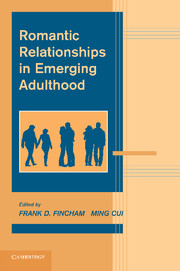Book contents
- Frontmatter
- Contents
- List of Contributors
- Foreword
- PART I INTRODUCTION
- PART II CONCEPTUAL AND METHODOLOGICAL FOUNDATIONS
- PART III THE DEVELOPMENTAL CONTEXT OF ROMANTIC RELATIONSHIPS IN EMERGING ADULTHOOD
- PART IV RELATIONSHIP PROCESSES IN EMERGING ADULTHOOD
- 9 The Evolution of Romantic Relationships: Adaptive Challenges and Relationship Cognition in Emerging Adulthood
- 10 Initiating and Evaluating Close Relationships: A Task Central to Emerging Adults
- 11 Putting the Romance Back Into Sex: Sexuality in Romantic Relationships
- 12 Understanding Romantic Relationships Among Emerging Adults: The Significant Roles of Cohabitation and Ambiguity
- 13 Implications of Parasympathetic Nervous System Functioning for Affect Regulation and Romantic Relationships in Emerging Adulthood
- PART V PRACTICAL IMPLICATIONS
- Index
- References
13 - Implications of Parasympathetic Nervous System Functioning for Affect Regulation and Romantic Relationships in Emerging Adulthood
Published online by Cambridge University Press: 06 December 2010
- Frontmatter
- Contents
- List of Contributors
- Foreword
- PART I INTRODUCTION
- PART II CONCEPTUAL AND METHODOLOGICAL FOUNDATIONS
- PART III THE DEVELOPMENTAL CONTEXT OF ROMANTIC RELATIONSHIPS IN EMERGING ADULTHOOD
- PART IV RELATIONSHIP PROCESSES IN EMERGING ADULTHOOD
- 9 The Evolution of Romantic Relationships: Adaptive Challenges and Relationship Cognition in Emerging Adulthood
- 10 Initiating and Evaluating Close Relationships: A Task Central to Emerging Adults
- 11 Putting the Romance Back Into Sex: Sexuality in Romantic Relationships
- 12 Understanding Romantic Relationships Among Emerging Adults: The Significant Roles of Cohabitation and Ambiguity
- 13 Implications of Parasympathetic Nervous System Functioning for Affect Regulation and Romantic Relationships in Emerging Adulthood
- PART V PRACTICAL IMPLICATIONS
- Index
- References
Summary
The romantic relationships of emerging adulthood (EA) pose a range of new psychological and emotional challenges that are unique to this stage of life. As youths make the transition from the casual romantic ties of adolescence to more serious and substantive relationships, the “stakes” of day-to-day relational maintenance become progressively higher. Furthermore, the greater depth and complexity of emerging adults' romantic ties place new demands on skills related to conflict resolution, negotiation, responsiveness, accommodation, sacrifice, and compromise. During this stage of life, romance is no longer “just fun” – the work of building and sustaining a long-term pair bond has begun.
Effective self-regulation, more generally, and affect regulation, in particular, are critical to this transition. Self-regulation is broadly defined as the process through which people control and correct their own goal-directed behavior (Aspinwall, 2001; Baumeister, Schmeichel, Vohs, Kruglanski, & Higgins, 2007). Affect regulation refers to the internal and transactional processes through which individuals modulate the experience or expression of positive and negative affect (Gross, 1999; Larsen, 2000). Patterns of affect regulation shape the ways in which individuals perceive, appraise, and react to emotionally relevant relationship experiences (reviewed in Diamond & Hicks, 2004). They are also fundamentally integrated with broader self-regulatory processes, including executive functioning, response inhibition, and the regulation of attention (Koole, 2009; Posner & Rothbart, 2007); hence individual differences in emerging adults' affect-regulatory capacities influence the initial direction and long-term course of their romantic relationship trajectories.
- Type
- Chapter
- Information
- Romantic Relationships in Emerging Adulthood , pp. 252 - 272Publisher: Cambridge University PressPrint publication year: 2010



